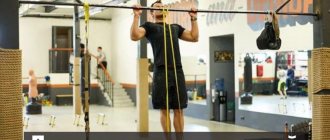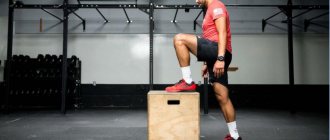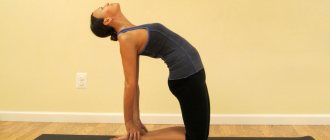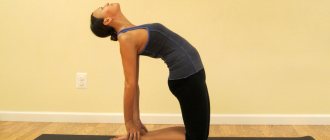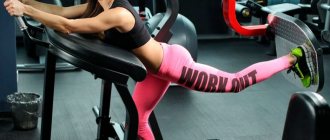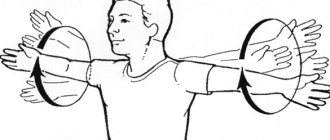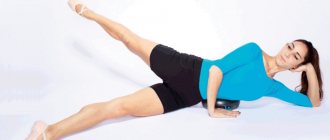Side bends with dumbbells are performed by athletes to strengthen the oblique abdominal muscles and reduce waist size. However, despite the simple technique, this exercise is often included in the training process incorrectly, which leads to exactly the opposite results. The waist increases in width due to the development of muscles, and the fat layer does not shrink even a centimeter.
Let's figure out how to do side bends in order to achieve exactly the goal that you planned, in particular - losing weight.
Features of the exercise
Side bends can be performed using various techniques and methods. The classic version assumes a starting position - standing, with your feet shoulder-width apart, and your hands either on your waist, or one hand on your waist and the other above your head.
The tilt must be carried out to such a position until a person feels tension in the muscles of the legs and in the lateral abdominal muscles. When the torso reaches the lowest point, you should hold the position for a few seconds, and then return to the starting position.
Tilts should be done in different directions, lingering at the bottom in both directions. They can also be combined with forward and backward bends, as well as hip rotation, to achieve more dynamic movements and better results.
Exercises are beneficial for anyone, even children.
It is especially advisable to perform them for those people who want to strengthen their abdominal muscles and make their waist smaller. It is also useful to do them for people trying to lose weight.
However, if you overdo such exercises, you run the risk of pumping up your lateral abdominal muscles and getting a rectangular waist.
Who benefits from this exercise?
It is believed that bending to the side is one of the easiest ways for girls to make their waist slimmer.
At the same time, among those who want to lose weight, there are real horror stories that if you do this exercise too often with a large number of repetitions, you can pump up your muscles and achieve a rectangular figure that does not have any prominent parts or attractive curves. Where is the truth? In fact, bending to the side is practically useless for the waist. This exercise primarily develops the oblique abdominal muscles and some of the spinal muscles of the core. With a small number of repetitions, it will help improve the overall tone of the torso and slightly tighten the stomach. If you perform it in a “fat-burning” mode - with preheating, a large number of repetitions and weights - you can really develop muscles and get rid of excess subcutaneous fat. Bodybuilding fans advise doing side bends 50-100 times on each side.
Side bends - what muscles work
Side bends are extremely beneficial for human health. During lateral bending, tension is felt not only in the oblique abdominal muscles, but also in the legs. The main rule is to keep your back perfectly straight to avoid injury to the spine and joints.
During the bend, the main muscle groups are involved, namely the obliques, buttocks, legs, back, thighs and buttocks. If you perform a muscle bend using weights, the result will be better than without it.
Performance
Take the weight in your right hand. Place your free hand (left) on the oblique abdominal muscles on the left to “feel” how these muscles will work. Lean to the right - as far as possible without feeling discomfort. Then return to a vertical position. Do all repetitions, always leaning to the right, without interruption. Then take the weight in your other hand and work the opposite side of your body. While performing a set, do not turn your head to the sides or tilt down - look straight ahead.
Movement should only occur sideways. Don't lean forward, don't lean back, or try to move in an unnaturally large amplitude.
Do not put too much load on the leg that is on the side of the weight - otherwise, you risk losing your balance and falling to that side.
Do the repetitions carefully - the upward movement should last about two seconds, the downward movement the same. Or, you can do the exercise even slower—4 seconds up, 4 seconds down—and reduce the number of reps per set. Don't do the exercise hastily. It is very important that the movement is smooth and that you control its negative phase even after the last repetition, when you want to put the weight on as quickly as possible. When going down, inhale, when going up, exhale.
After an intense set of bending to one side, rest for a couple of minutes before moving on to bending to the other side. This will help you take a breath, gain strength and do a better set.
If in one workout you do the first set of bends, for example, to the right side, then in another workout, on the contrary, do the first set of bends to the left.
Exercise technique
It is very important to perform the bending exercise with a straight torso during the exercise. The legs should not be bent at the knees; the hands should be kept either at the waist or above the head, depending on the variation.
You can supplement the technique by tensing certain muscle groups. For example, by tensing the gluteal muscles while bending, you can tighten them and make them more elastic. You can strain your abs, arms, legs. The effect will depend on this.
While bending, you must not go at an angle backward or lean forward too much. This can lead to spinal injury or even joint dislocation.
The peculiarity of performing tilts in the classic version is that they are repeated about 10 times in each direction. You can continue the exercise after a short break. Thus, the number of approaches can be up to three.
But people who have only recently begun to engage in physical activity should not overload their body and it is better to start with a small number of repetitions.
Bent over dumbbell swings: main points when performing
Bent over dumbbell swings can be performed in several variations. But for each of them there are basic (uniform) rules that you need to know and use.
- Turn off the trapezoid. In order for the load to go specifically to working out your deltoids, we need to exclude the trapezoid. To do this, we need to stretch it properly, dropping our shoulders as low as possible. Having done this, we will lift the weight by contracting the rear deltoids, not the trapezius. This way we can focus on working the muscles we need.
- We work with our elbows. You also need to exclude the triceps from the workout; to do this, you need to focus all your attention on the movement of your elbows. To do this, you need to imagine that your arms end not with dumbbells, but with elbows. These are the ones you need to move up, concentrating all your attention on contracting the rear delts.
- Proning (turning) the hand. Pronating the hand at the top point will help to properly isolate the rear deltoid. During the lift, we begin to rotate the dumbbell counterclockwise (in the direction of the thumb). As a result, the thumb will point towards the floor, and the little finger will point upward. It's like we're pouring water out of bottles.
- Hand movement is strictly in the vertical plane. Hands should move in a straight path relative to the shoulders, without moving forward or backward. If you move your elbows back, the exercise turns into something like dumbbell rows aimed at training your back. If you bring them too far forward, it will become more difficult to maintain balance.
These four rules are fundamental and cannot be broken. Indeed, in any version of bent over swings, the execution technique is almost the same.
Variations of the exercise
Side bends can be performed not only in the classic version that we are used to seeing in gyms or fitness centers. They may be of slightly different varieties. Among the most common variations are the following:
- with weighting material;
- sitting on a chair or bench;
- bending in the simulator;
- with body twisting;
- with tension in additional muscle groups.
Options for tilting the body to the sides can be performed not only as a classic technique, but also with additional weighting. You can use water bottles or dumbbells as this. To do this, you need to take a dumbbell in one hand and place the other either behind your head or at your waist. Starting position: standing, feet shoulder-width apart or slightly wider.
The weight of the dumbbell should be selected individually, depending on the individual characteristics of the human body and his physical endurance. If a woman does side bends, then you can pick up two or three kilogram dumbbells. For a man, you can take heavier weights. For beginners, you can choose very light weights, for example half a kilogram.
The optimal number of repetitions would be about 10 times on each side. But if a person works with a professional trainer, then he can prescribe a different training regimen.
Bends while sitting on a chair or bench will not be as effective as those performed while standing. I can prescribe them to people suffering from joint diseases or having problems with their legs.
If a person wants to additionally work out the muscles of the abdomen and lower back as effectively as possible, you can do an exercise with torso twisting. To do this, you also need to take the starting position while standing, as in the classic version, then place one hand behind your head and place the other on your waist. After this, move the body down and to the side, additionally twisting it towards the leg that is located below, trying to reach it with the opposite hand.
While bending, you can strain the muscles of the abs, back, arms, and buttocks. This will allow you to influence not only the lateral abdominal muscles, but also those muscles that will tense during exercise.
Analysis of the exercise
Anatomy of an exercise: which muscles work?
Side bends with dumbbells are an isolating exercise, which is an integral element of training complexes for strengthening and developing the strength potential of the corset muscles, in particular their lateral segments - the internal and external obliques. Contrary to popular belief, bending the body with weights is not able to destroy fat deposits in the waist area - this task can only be solved through diet and aerobic exercise.
In addition to the target oblique abdominal muscles, the following also take part in the movement:
Preparing for the exercise
To pre-warm the muscles involved and improve the flexibility of the spine, it is recommended to perform a 5-minute warm-up, including in the overall complex standard bends to the sides (with the hands held in the lock on the back of the head) at a slow pace and axial turns (the pelvis remains stationary, and the turn is carried out only by the upper part body).
How to do it correctly
Efficiency Tips
Errors
Including an exercise in the program
Bend-overs are included in abdominal training programs along with other exercises for working the oblique muscles, but are usually performed in the final part of the session.
Mode of operation: The standard for this exercise, as for most abdominal movements, is high-repetition work in the range of 12-15 repetitions (for each side).
For athletes who have included standing lateral bends with dumbbells in their “weight loss” strategy, the intensity of the work should be increased by increasing the tempo of movement, reducing pauses between sets and performing the exercise in a high-volume style for 20-25 repetitions.
Weight used. Women with standard figure optimization goals are not recommended to perform the exercise at all. But if there is a “professional” need for such training (for example, when practicing contact sports), you should use a light dumbbell of 2-4 kg. For men, the optimal weight of the projectile is selected based on training experience and physical fitness, and usually varies in the range from 4 to 10 kg.
Contraindications
Bends with dumbbells to the sides while standing poses a danger for athletes with an injured back (vertebral displacements, intervertebral hernias, protrusions, osteochondrosis). Also exclude bending from your training program if you experience even minimal discomfort when doing it.
Contraindications and precautions
Like any other type of physical activity, bending to the sides has some contraindications. They are not recommended for those who have the following situations:
- pregnancy;
- pain in the lumbar region;
- spinal injuries;
- oncological diseases;
- period of exacerbation of chronic diseases;
- high body temperature;
- loss of energy and depressive disorders;
- mental disorders;
- blood pressure disorders;
- old age after 70 years;
- viral and infectious diseases;
- bad feeling.
If a person feels well, but has any deformities of the spinal column, he should first consult an orthopedic doctor. He, in turn, will assign or prohibit bending to the sides. This applies even to those people who have a history of spinal curvature, even in a mild form.
Such people should be especially careful to ensure that their back is perfectly straight during exercise.
During pregnancy, it is theoretically possible to engage in this kind of exercise, however, if a woman has never exercised before pregnancy, this can negatively affect her health. In this case, the activity can only be useful for those women who played sports before pregnancy and have a sufficient level of sports training.
Contraindications for implementation and possible problems
It is strictly forbidden for those who have suffered any spinal injuries to bend in either direction. If you have any problems with your back (for example, curvature) or suffer from regular lower back pain, you should not exercise without consulting a specialist. If during training you feel pain and discomfort, you should stop exercising. Also, you should not exercise until you drop; you should stop bending as soon as you feel obvious tension in your legs.
How not to bend over
This exercise is very useful for any person who has no contraindications or any restrictions. Bends of the body to the sides must be performed strictly in a certain sequence and have a special technique. If you don't follow simple rules, you can seriously harm your spine.
You cannot use additional attributes during class if a person has problems with the joints or spine. Moreover, if a person wants to strengthen the abs and back as much as possible, he should visit a specialist so that he can recommend the most effective way to perform the exercise and eliminate possible injuries.
You cannot tilt in either direction too quickly or, conversely, too slowly.
The most common mistake is to accelerate movement in one direction or another.
Thus, a person receives additional unreasonable stress on his lower back, and this has an extremely adverse effect on his health.
Errors during execution
- Rounding the back. Keep your back straight throughout the entire exercise. Otherwise, you can injure your back in the lumbar region.
- Using heavy dumbbells. This exercise is performed with light dumbbells, since we are training the deltoids. If the weight exceeds our capabilities, the back comes into play and takes the entire load upon itself.
- Hit the dumbbells against each other at the lowest point. To prevent this, you need to control the exercise. We raise and lower the dumbbells slowly, concentrating on working the rear deltoids. If we lower our arms under the weight of dumbbells involuntarily, we can injure our shoulder.
- Movement in the elbow joint. This exercise is isolated, which means the work should occur in only one joint, the shoulder. Therefore, the elbows must be fixed throughout the entire execution.
- Reduction of the shoulder blades at the top point. We have already talked above about the need to turn off the trapeze from work. This is done to ensure that only the muscle we need works. If you bring your shoulder blades together at the top point, then the trapezius and back muscles are involved in the work. Then the whole point of our training will be lost.
Good luck to everyone in your training!
What should you combine tilts with?
The most effective combinations of side bends include crunches while lying on a bench, leg lifts, and forward bends using a barbell or without weights.
Thus, a person provides himself with maximum load on his back and abs. Depending on the desired result, it is necessary to build on a set of selected activities. In order to strengthen the abdominal muscles, you can combine these exercises with additional stress on the abdominal muscles.
The benefits of bending are significant for any person, even if it concerns those who have never engaged in this type of activity. In this case, you just need to be extremely careful to avoid back injuries.
What does the slant of handwriting indicate?
Author: Inessa Goldberg, graphologist, forensic graphologist, head of the Inessa Goldberg Institute of Graphanalysis, full member of the Scientific Graphological Society of Israel
Today I will share with you some professional considerations about one of the most noticeable and obvious graphological features even to the inexperienced eye, which is why it has deserved special attention and popularity - the slant in handwriting.
To avoid a superficial answer in the “signology” style that we most often find on the Internet and popular sources, with the help of this article I would like to give, if not exhaustive (there are always many more nuances), then a much more accurate idea of this phenomenon.
I didn’t use the expression “On an oblique way” for a catchphrase; it also carries a deeper meaning associated with the concept of slant in handwriting - and you will soon see this by delving into the analogies I use for explanation.
So, slant in handwriting. Most often I am asked about left or right, but let's pay attention - there is also a direct slant (handwriting without slanting). These three main types of inclination also have variations, and we take into account at least three or four subtypes of the right and left inclination (light, medium, strong, creeping) and possible fluctuations in the “almost straight” inclination.
It should be said that any feature in handwriting, including slant, cannot be interpreted separately from the overall picture and in combination with the rest of the “graphic circumstances” of a particular handwriting. Considering this, you can get a lot of information.
In general, the slope “shows” one of the main tendencies in the structure of a person’s personality, his direction, his nature and how he manifests it. Take a close look at the illustration above, and now the most important thing:
Psychomotor-wise, the right tilt (we are talking about an ordinary right-handed person; a left-handed person is forgiven by a few degrees of tilt to the left, after which all other rules of handwriting analysis are fully applicable to him) is the most natural and least energy-consuming. This provides the optimal channel for both releasing expression and achieving the result most efficiently. Thus, in general, we can say that the right tilt provides the opportunity for the most productive expenditure of energy relative to the dynamism being developed - by analogy with “running down a mountain.”
However, I want to emphasize the multifactorial nature of the sign - something on which the interpretation of the slope will depend. “Running from the mountain” is more convenient, easier and more optimal from the point of view of spending energy, but the right slope is only a “descent”, “mountain”, “favorable condition”, and all the “positive”, healthy and prosperous characteristics of the right slope known to us will be true and are reliable only under the condition that a person knows how to “run” relatively correctly and apply effort. The right tilt is not enough to infer better qualities.
If the owner of the right tilt uses its advantages to “roll head over heels”, rush forward without thinking about the consequences, or, on the contrary, uses this “descent” for a passive, motionless roll by inertia - this is different.
“Fluency” of handwriting comes from “running,” i.e. from healthy dynamism, and not from “obsessively running head over heels” or from “passively sliding downward by inertia.”
Handwriting snippets - from handwriting submitted to the public forum
In the case of (1) healthy fluency, to which the right tilt is conducive, we will talk about a set of qualities that express the spontaneity of the individual, natural expression of oneself, liveliness, sincerity in the expression of one’s feelings, disposition towards people, active life position, etc. (there are many meanings, some of them can be found in my books).
In the case when the right tilt (2) provokes, or rather accompanies, violent, impulsive, instinctive impulses - the meanings will be corresponding - impatience, impatience, inconstancy, contempt for norms and obligations, drives, incontinence, a person of extremes, etc. will come to the fore. .
In the case of right-leaning (3) sluggish, when it serves only as the “path of least resistance” for inert movement, completely different meanings will take place. For example, lack of will, spinelessness, compromise, lack of depth, thoroughness, personal opinion, as well as depth of feelings and involvement. There are many dozens of values, everything will depend on additional parameters in the handwriting.
In general, the right tilt, we repeat, is our “nature”, a manifestation of feelings, instincts or lethargy, and it is associated with the dynamic parameters of handwriting, with movement. Direct slope - psychomotor predisposes to restraint and greater conscious control, mediation, calculation or monitoring of one’s behavior, rationality. The direct slope is more closely associated (combined) with structural or disciplinary parameters in handwriting - organization, etc. If it becomes not just rationality and balance, but defense (simply calculation, rationalization, artificiality), then the structure in the handwriting will not be natural, it will be artificial, and the form in the handwriting may also come to the fore.
If the right slope is “descent”, then a straight line can be compared to a straight surface. It doesn’t make movement much more difficult, but it doesn’t make it easier or faster either. Each step is made “consciously” and requires some effort, “decision making”. A person is more driven by internal logic, expediency or other considerations than by the spontaneous manifestation of his nature. And then we again look at how the direct slope manifests itself in different people. Is it stable, static, or alive, variable, very fluctuating, or obsessive, obsessive, etc.
The analysis occurs similarly with the left slope, with the difference that we can conditionally imagine it as “resistance”, “climbing uphill”. Many are accustomed to reading in popular articles that the left tilt is the “voice of reason” or “head”. Traditionally, but completely unreasonably, it is assumed that the right slope is the “heart”, which means that the left slope is “mind”, and the straight slope, of course, is the “golden mean”. It sounds beautiful and symmetrical, but psychomotor studies say something completely different, and “perfect harmony of mathematics” is far from reality.
The left tilt is opposition, positioning oneself “against” the environment. Psychomotorally, this is the most uncomfortable movement when writing. However, if a person prefers it, then there are reasons. This means that the state of opposition, sometimes outsider or confrontation, is more important to him than convenience.
Common mistakes
The most common mistakes when performing this type of exercise are the following.
- Plane offset. In this case, the person’s torso does not go at a right angle to the side, but moves slightly forward or backward. Such a mistake can be very serious for the spine.
- If a person uses weights, a common mistake is choosing a weight that is too heavy or too light for him. This can be corrected by selecting the weight of a dumbbell or barbell individually in consultation with a trainer.
- Another mistake is relaxed abdominal muscles. When bending, the abs should be tense to remove excess stress from the lower back and at the same time strengthen the abs.
A common mistake is not tilting the body enough. This mistake is extremely rare; mostly people strive to perform the exercise as hard and as efficiently as possible.
Nuances
When performing side bends with dumbbells, you need to adhere to some recommendations, for example:
pay attention to the movement of the sports equipment, it should slide parallel to the line of the leg; You should not bend over until you feel pain; bending occurs due to the work of the abdominal press, and not other muscles; the maximum point of inclination is characterized by a slight lifting of the torso and a short-term delay in position; involuntary deviation of the torso forward or backward is excluded; It is not allowed to perform the exercise with fragmentary movements; It is not recommended to use heavy weights; The number of approaches and repetitions varies depending on the degree of physical fitness.
Training is carried out no more than 2 times a week.
Useful tips
The main recommendation when performing bent-over dumbbell raises is a gradual progression of the load. Do not rush and use dumbbells that are too heavy during the training process. This exercise is not basic and will not help build muscle volume in the rear deltoids.
The best option for beginners would be to introduce bent over flyes into the training process without using additional weight or with dumbbells weighing no more than 1-2 kg. At the initial stage, it is important to establish a neuromuscular connection between the brain, the central nervous system and the contracting muscle.
In other words, wiring should be done consciously. You need to understand how strongly the rear delta is contracted at a given moment. And also be able to provide the necessary impulse so that the muscles contract even stronger.
When using large working weights, it will not be possible to achieve a similar effect, since the movement will be carried out automatically. The exercise will turn into flyes and swings. Which is absolutely not recommended.
In addition to contracting the muscle, it is necessary to pay attention to its stretching in the negative phase of the movement. Without high-quality and amplitude stretching, it will not be possible to achieve correct and complete contraction. And without a complete contraction, lateral raises with dumbbells make no sense.
Warm-up option before performing rear delt exercises with weights (for example, dumbbell flyes)
When working on the muscles of the shoulder girdle, you should pay great attention to warming up. The joint moves in several planes and if you do not warm up enough before exercise, it is easy to pull any of the deltas. For warming up, you can use joint gymnastics complexes. They should be performed before perspiration appears.
When performing a standing lateral raise, you can use an athletic waist belt. It allows you to reduce the load on the spine and makes it possible to concentrate on performing the exercise. You can also use wrist straps. They will help get rid of problems associated with holding dumbbells in the desired position. This allows you to better concentrate on the work of the deltoid muscles.
Bend forward with dumbbells
These standing dumbbell dips are not as popular as the previous ones, but you can combine them for better results. Bends forward with dumbbells can strengthen your hamstrings, glutes, back, trapezius muscles and forearms. The obliques and any other abdominal muscles are practically not involved in the exercise.
Standing forward bends with dumbbells involve working with two weights. Feet are placed shoulder-width apart, knees slightly bent. The back should be flat or slightly arched at the lower back. When you bend over, do not round it and look only straight. It is necessary to do 12 - 15 repetitions of the movement, as well as several approaches.
Dumbbell forward bend and side bend exercises cannot be considered interchangeable exercises. They affect the body in completely different ways. Therefore, it is acceptable for an athlete to add both types of movements to his training, combining and combining them.
Girls should be careful when performing bending exercises with dumbbells, since they, if overloaded, can make the waist visually wider. But this warning does not apply to forward bends.
Men are recommended to perform both types of bends with dumbbells for the waist. Only instead of dumbbells, when bending forward, you can use a barbell - it will allow you to work out your muscles better. slopes with dumbbells for girls
You will be interested in: Hamstring muscles Classic bodybuilding Training with dumbbells for men and girls Push-up course It's time for awesome stories. Part 3
How to train correctly?
To lose weight and reduce fat on the sides and abdomen, the exercise should be performed according to the following scheme:
- First of all, you need to overcome the desire to take a heavy dumbbell. Firstly, it is dangerous for the spine. Secondly, training with heavy weights leads to muscle growth, and increasing the volume of oblique muscles is not part of our plans. The weight should be no more than 5–7 kg for men and no more than 3–5 kg for women. It is better to take less weight, but do more repetitions.
- We do at least 20 repetitions on each side, 3-4 approaches. We take minimal rest between sets. Alternate approaches left and right.
- The repetitions are performed at a relatively fast pace, but without jerking and always with tense abs.
- It is better to include side bends in the training program as an additional exercise. That is, we leave it at the end of the workout, when the main exercises have already been completed.
A significant fat-burning effect is achieved only with appropriate adjustments to the diet. Also, the process of losing weight will go faster with increasing cardio loads.
There is a popular myth that exercise can remove fat from a certain part of the body. But, in fact, there is no local weight loss, and until a certain calorie deficit is created, fat deposits on the waist and sides will not begin to decrease, no matter how many bends you do.
Bends alone are not enough to lose weight. The nutritional plan must be adjusted.
But what if your goal is not to burn fat, but to work out your abdominal muscles? In such a situation, it must be said that the oblique muscles, one way or another, are involved in the work when performing any abdominal exercises. Of course, you can additionally load them with tilts, the main thing is to strictly follow the technique.
To work the muscles:
- Side bends are performed slowly.
- 8–12 reps on each side, 2–3 sets. We alternate approaches to the left and to the right.
- You still can’t take on a lot of weight.
Essence and basic principles
Bent-over dumbbell flyes are an isolated single-joint exercise. This means that if the correct technique is followed, only one shoulder joint is involved in the movement process. All other joints of the human body must be static or maintain a given position.
When performing bent-over lateral raises, the following muscle groups are included in the work:
1. Back muscles:
- Teres major muscle;
- Trapezius muscles.
2. Deltoids:
- Posterior deltoid;
- Middle deltoid.
3. Shoulder muscles:
- Triceps and biceps.
The last muscle group bears the static load of holding the arm with weights in a given position. The biceps and triceps muscles balance each other, maintaining the necessary bend in the elbow, preventing the forearm and hand from approaching the shoulder.
Standing dumbbell raises engage many small stabilizer muscles. With this version of the exercise, static tension is present in the muscles of the core and lower body.
Varieties of dumbbell bent over raises
There are several main types of dumbbell raises: standing, sitting and supported.
Standing breeding
It is necessary to begin this exercise by mastering the correct starting position. This requires the practitioner to have flexibility and developed muscles in the midsection.
Technique:
- First you should straighten up and take a vertical position. At this stage, it is important to feel the natural deflection in the lumbar spine. In the future, in order to reduce the risk of injury, it will need to be observed.
- Take dumbbells. The upper limbs should be slightly bent at the elbows.
- Tilt the body parallel to the floor. In this case, the deflection in the lower back should be natural. Slouching and rounding in both the lower and upper back are not allowed. Particular attention is paid to the angle of inclination of the body. If the practitioner lacks flexibility or elasticity in the muscles of the back of the thigh, then a slight bend in the knee joint is allowed. The pelvis can be moved back a little.
- After the athlete has placed his body in a horizontal position, attention should be paid to the position of the shoulders. They should be unfolded and lie on the same imaginary line. If the shoulders are lowered down or raised high, the amplitude of the exercise will be reduced. In this case, it will not be possible to achieve peak contraction and stretching of the target muscle.
- Hands. One of the main points is the position of the hands. The elbows should be slightly turned outward. This will allow them to be moved apart from each other in the same plane. This movement path is necessary for training the rear delts. If you leave your elbows in a natural position, it will become much more difficult to control them. With general fatigue and due to the anatomical features of the structure of the human body, the main load, in this case, will be taken on by the stronger teres major muscles. And the lateral raise will turn into a bent-over dumbbell row.
Bent-over dumbbell flyes for the rear deltoids are a technically difficult exercise. High demands are placed on the position of the student's body.
If the angle between the horizontal and the line of the upper body is more than 15-20 degrees, then the load will shift from the rear delta beam to the middle one. If the angle is negative, the tension in the lower back will exceed the permissible level. In this case, the risk of injury will increase significantly.
Sitting breeding
Raising dumbbells to the deltoid muscles from a sitting position differs from the previous version in the presence of a fulcrum. The practitioner selects the height of the bench so that the hips are positioned slightly below the horizontal. In this case, the knee should be lower than the upper thigh. This is necessary to ensure the correct position of the body.
You should also pay attention to the correspondence between the height of the bench and the length of the athlete’s arms. At the lowest point of the trajectory, the dumbbells should go under the thigh and not touch the floor. Bending the arm at the elbow joint is not desirable.
This version of the exercise is suitable for beginners. The presence of support allows the athlete to get rid of the need to monitor the position of the body. The chest fits tightly to the thigh, and the lower limb itself is rigidly fixed to the floor surface. This makes it possible to create a stable system in which the athlete can concentrate on working the rear delts.
Disabling the core muscles (all abdominal muscles, oblique abdominal muscles) allows you to use slightly larger weights. Seated lateral raises allow the athlete to take a more stable position. This helps achieve better muscle failure in the rear delts.
Bent-over dumbbell raises with support
To perform the exercise in a supported version, you can use a hyperextension machine or an athletic bench with an adjustable backrest.
This version of the dumbbell raise in an incline for the rear deltas allows you to completely relieve tension from the back and legs. This is necessary in cases where the student has a weak core and, due to the peculiarities of the body constitution, cannot perform seated flyes.
With this version of the exercise, the starting position directly depends on the choice of auxiliary equipment. The hyperextension machine does not change the basic recommendations. When using a decline bench, it is important to understand the functional tasks facing the target muscle group.
The posterior deltoid muscles pull the elbow back when the shoulder is horizontal. Thus, you can choose any angle of the bench. However, it is necessary to ensure that a right angle is maintained between the body and the upper limbs.
It should be remembered that if the angle between the body and the floor is close to 90 degrees, part of the load will be taken over by the anterior deltoid muscles.
What exercises to do
There are many exercises with dumbbells; it makes no sense to list them all. Lifehacker selected the most popular ones and divided them into muscle groups.
To create a full-body workout, just select 1-2 exercises from each group. Perform exercises in 3-5 sets of 8-12 times. Select the weight in such a way that the last repetitions of the set are difficult, but the technique does not deteriorate.
If your dumbbells are too light to thoroughly load your muscles in 12 reps, increase the number of repetitions per set. At the end of the exercise, the muscles should feel tired.
When to expect an effect
The rear delta is a small muscle that experiences constant static load. It keeps the shoulders turned and does not allow them to round. Therefore, any dynamic loads associated with contraction and relaxation create numerous microdamages in its fibers.
With the correct sleep and rest regime, the rear delta can noticeably increase in volume after 4-5 workouts.
However, a lot depends on the starting base. If a beginner athlete begins to perform this athletic movement, the first results can come in 7-8 weeks. This is due to the fact that his body is just beginning to get used to training and has not yet developed reaction mechanisms to it.
Bent-over dumbbell raises to the rear deltoid are an integral part of the training process for those people who are focused on maintaining correct posture and strengthening the spine.
Thanks to the presence of 3 variations: standing, supported and sitting, this sports movement is suitable for all categories of athletes and has no special contraindications.

